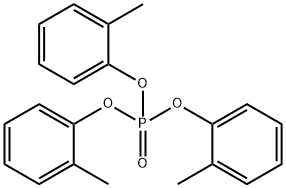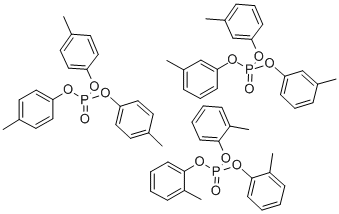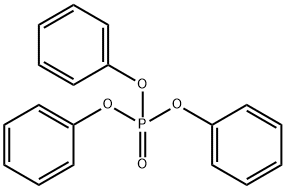PRODUCT Properties
| Melting point: | -25 °C |
| Boiling point: | 410 °C |
| Density | 1.2 |
| vapor pressure | 0.195 at 50 °C (Carré and Bertrans, 1998) |
| refractive index | 1.558-1.561 |
| Flash point: | 225 °C |
| storage temp. | under inert gas (nitrogen or Argon) at 2-8°C |
| solubility | sparingly soluble in water; soluble in acetic acid; freely soluble in
alcohol, benzene, ether; very soluble in carbon tetrachloride, toluene. maximum allowable concentration: 0.1 mg/m3 (TLV-TWA) (ACGIH 1986) |
| form | Viscous Liquid |
| color | Clear colorless to yellow |
| Merck | 14,9764 |
| Exposure limits | TLV-TWA skin 0.1 mg/m3 (ACGIH and OSHA); IDLH 40 mg/m3 (NIOSH). |
| CAS DataBase Reference | 78-30-8(CAS DataBase Reference) |
| EPA Substance Registry System | Tri-o-cresyl phosphate (78-30-8) |
Description and Uses
TOCP finds wide applications in several areas. It is used as a flame retardant; as a plasticizer; as a waterproofing agent; as a synthetic lubricant; as an additive in gasoline to control preignition; and in hot extrusion molding, hydraulic fluid, and solvent mixture for resins..
Safety
| Symbol(GHS) |   GHS08,GHS09 |
| Signal word | Danger |
| Hazard statements | H370-H411 |
| Precautionary statements | P260-P264-P270-P307+P311-P321-P405-P501 |
| Hazard Codes | N-T,N,T |
| Risk Statements | 51/53-39/23/24/25 |
| Safety Statements | 61-45-28A-20/21-28 |
| RIDADR | 3082 |
| OEB | D |
| OEL | TWA: 0.1 mg/m3 [skin] |
| RTECS | TD0350000 |
| HazardClass | 6.1(a) |
| PackingGroup | II |
| HS Code | 29199000 |
| Hazardous Substances Data | 78-30-8(Hazardous Substances Data) |
| Toxicity | Acute oral LD50 for rats 160 mg/kg (quoted, RTECS, 1985). |
| IDLA | 40 mg/m3 |






